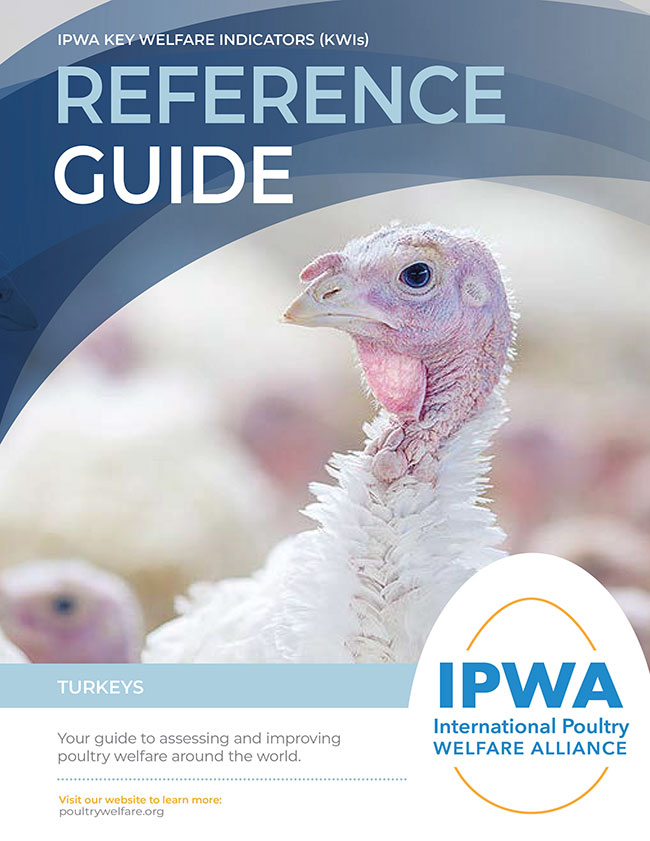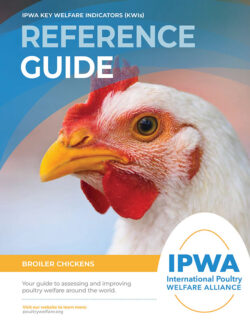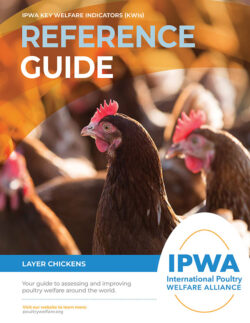
Alliance unveils new poultry welfare assessment tools
By Ronda Payne
Features Bird Management WelfareA new set of guides developed by the International Poultry Welfare Alliance has been introduced to complement the existing Canadian codes for broilers, layers, and turkeys. These guides are specifically designed to cater to the needs of farmers at any stage of their poultry farming journey.
 The International Poultry Welfare Alliance recently published three new Key Welfare Indicator guides.
Photo: International Poultry Welfare Alliance
The International Poultry Welfare Alliance recently published three new Key Welfare Indicator guides.
Photo: International Poultry Welfare Alliance No one is resting on their laurels in Canada when it comes to poultry welfare. With an already enviable mandatory program for farmers, it would be possible, even easy, to say “good enough,” but, the International Poultry Welfare Alliance (IPWA) has published its Key Welfare Indicator (KWI) Guide this spring and this tool can serve as another layer (no pun intended) of support for farmers advancing the wellbeing of their poultry.
Canadian standards stand out
Elyna Myhre, director of marketing and communications for IPWA, says Canadian producers should be proud of what they have already accomplished and the new guides can help get to the next step.
The Code of Practice for the Care and Handling of Pullets and Laying Hens and the Code of Practice for the Care and Handling of Hatching Eggs, Breeders, Chickens and Turkeys were both created by teams of experts to provide a standard of care. These codes are the basis for the nationally enforced animal care audit.
“Nowhere else in the world has a mandatory minimum animal care program that all farmers must pass regardless of their size, except for Canada and our five supply managed commodities,” she says. “Because of our mandatory standards, we are also in a very unique position to ensure that all our birds’ needs are met.”
While the new KWI guides are intended for a global poultry-producing audience that may not have the regulatory information and support Canadian producers do, there is still much benefit to be gained from the new documents. They can be seen as a resource for individual pieces of information or a collection of practices.
The choice in use is the farmers.
Similarities and differences
Farmers joined a number of people in creation of the new guides and it was far from an academic exercise. Nearly 60 individuals served as primary authors as well as being members of the IPWA Poultry Health and Welfare Committee.
Myhre explains that the team members included production managers, farmers, welfare program supervisors, business owners, veterinarians and “other professionals actively involved in the creations, implementation or verification of welfare protocols for poultry.”
As she outlines, many of the audit requirements outlined in the codes are prescriptive in specifying minimum standards of resources to ensure good welfare.
“In contrast, the KWIs look at how resources are used and, in the case of the Layer KWIs that I helped to create, focus on animal-based measures as indicators of welfare,” she says. “The codes and KWI guides are not in competition, but rather, the KWI guides can be used as an additional resource by farmers.”
Based on life cycles
The guide is broken into the unique needs of broilers, layers and turkeys. It is then, in the case of a laying hen’s life, further split into the four phases of on-farm, processing, transportation and hatchery. Some of the KWIs are repeated in the different sections because they are relevant to those life stages but with different welfare implications and factors.
 To make navigation easier, the KWI’s include call-out boxes of key points, “start here” boxes to deliver initial information and QR codes to offer further information.
To make navigation easier, the KWI’s include call-out boxes of key points, “start here” boxes to deliver initial information and QR codes to offer further information.
“For example, injury tracking is relevant at the hatchery as an indicator of hatchery design, handling protocols and equipment use; injury tracking at processing may indicate handling issues at the layer farm, or equipment issues at the processor,” she explains.
Having tools like the codes and new guides that are focused on animal care and wellbeing provide a service not only to the farmer and producer, but also to the processor, wholesaler, retailer and consumer involved in the accessing and handling of poultry at all stages. Kathleen E Long, vice president of animal care with Maple Leaf Foods, says having the benchmarks (and science behind them) most important to animal welfare in the KWI guides is important for farmers.
Applying information on the home front
“Producers can use the information in the guide to implement farm-level KWIs in their own operations and monitor performance over time, with the goal of continually improving welfare outcomes,” she says.
She states that the agriculture industry inherently has an ethical responsibility to care for animals to the highest standards. It’s the spoken (and sometimes unspoken) promise that ensures trust between farmers, consumers and others in between.
“Tools like this help us to gather more data about animal welfare performance,” she says. “Enabling timely and effective corrective actions to improve the care we provide to our animals.”
There is flexibility built into the guides that appreciates the variety of management practices that are region specific, farm specific and even flock specific. This allows for continued growth and development both for the farmer, but also for scientists looking to further improve poultry welfare, according to Myhre.
“While there is already a recommended practice within the Canadian layer code for farmers to routinely conduct feather scoring to monitor their flock, the KWI Guide goes one step further, providing detailed background information and making some methodological recommendations based on the rigorous academic research that has already been conducted in this area,” she says. “However, the KWI Guide does not include an optimal level that a farmer should strive for with their flock since that depends on too many different
factors.”
Instead, the information with each KWI tends to be it’s own consideration with access to research and data that outlines the importance and details of various factors. In the KWI on litter quality, litter moisture is reviewed in a “hands-on” observation method as well as in a testing device method with several reference links to provide further details.
Manage what you measure
Long says KWIs are important to measure and validate an animal welfare program.
 “Although certain outcomes-based measures have been part of welfare audit standards for years, there has been a large increase in the use of KWIs more recently – both a greater breadth of KWIs and a demand for greater monitoring frequency,” she says.
“Although certain outcomes-based measures have been part of welfare audit standards for years, there has been a large increase in the use of KWIs more recently – both a greater breadth of KWIs and a demand for greater monitoring frequency,” she says.
Access to science-based information about the various factors that contribute to animal welfare outcomes and functional guides for implementation and measurement support Maple Leaf Foods. It offers a more complete picture of the realities of animal care when the prescriptive approach is integrated with the science around welfare outcomes.
“Maple Leaf Foods is highly supportive of the Chicken Farmers of Canada Animal Care Program, which is based on the National Farm Animal Care Council Code of Practice, to which all Canadian chicken farmers are audited for animal welfare practices,” she says.
Maple Leaf also conducts internal and third-party audits throughout the supply chain. She sees the new KWI guide as a benchmark to hold next to both the Canadian programs and that of Maple Leaf.
Guides for any farmer at any stage
Because the guides are a global aid, Myhre says there were discussions about the goal to “meet farmers where they are” and provide tools for measurement that could help improve poultry welfare regardless of what stage in farming they are at.
“For example, flock mortality is one key animal-based metric that can point towards the overall health of the flock,” she says. “The ‘start here’ form of this metric is to count the number of birds that have died, ideally on a daily basis. This alone is very helpful to see trends over time when compared to what is normal for that strain, housing type and age.”
Taking it a step further would be to divide mortalities into causes to help elevate issues that need attention.
While Canadian poultry farmers have access to a number of great tools to work to improve poultry health, the KWI guides fill a gap of knowledge without making the information mandatory in implementation. The shared science discoveries of poultry welfare will be a significant benefit to all farmers domestically and internationally.
Print this page